Choosing the correct sieve brush is vital for accurate testing and prolonging the lifespan of your sieves. Without the proper brush, residue from previous tests can compromise your results and the integrity of your test sieves. From nylon bristle brushes to those with wire handles, understand the role of meticulously crafted sieve brushes in your lab or industrial setting right here.
Key Takeaways
- Sieve brushes are vital for maintaining accurate testing results and extending the lifespan of test sieves, with various types and materials catering to different sieve meshes and usage scenarios.
- Selecting the proper brush for specific sieve meshes is essential to ensure efficient cleaning without causing damage, and different cleaning techniques must be employed for coarse and fine mesh sieves to preserve their integrity.
- Investing in quality brushes is beneficial not only for maintaining laboratory equipment, but also for ensuring the accuracy of testing results, and brushes should be properly maintained and stored to preserve their condition over time.
The Importance of Brushes
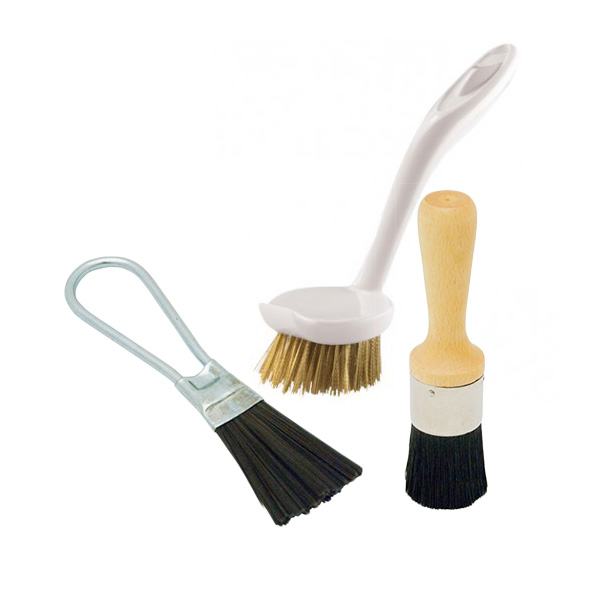
Sieve cleaning brushes do more than just clean your test sieves. They play a pivotal role in maintaining the integrity of your test sieves, which guarantees the delivery of precise aggregate testing results. Imagine sieving through a sample only to find your results skewed due to residual particles from the previous test. It’s not just frustrating but could also lead to inaccurate data and compromised quality control. This is where sieve-cleaning brushes come into play.
Among others, nylon bristle sieve brushes excel at:
- keeping your test sieves in top-notch condition
- guaranteeing the accounting of every particle and readiness of the sieve for the subsequent test
- significantly enhancing the lifespan of your test sieves and helping maintain their precision
When used correctly, sieve brushes are a crucial component in any lab or industrial setup.
Types of Brushes for Sieves
The diversity of brushes matches the variety of sieves they are intended to clean. They come in a range of materials, bristle densities, and dimensions to accommodate different sieve meshes and sizes. But why such a variety? The answer lies like the sieves themselves. Different sieve meshes, from stainless steel to brass, require brushes with appropriate bristle densities to prevent damage and ensure effective maintenance.
The materials used for sieve brushes include horsehair, brass wire, and with wood handles, each chosen for their compatibility with different types of sieve meshes. For instance, a brass wire brush may be ideal for coarser sieves, while a horsehair brush might be gentler and more effective for finer sieves. Sizes can range from compact 5.5-inch brushes to larger 13.5-inch brushes, catering to a variety of lab equipment sizes.
Selecting the Right Brush for Sieves
Choosing the appropriate brush for your sieve holds the same importance as cleaning the sieve itself. The correct brush ensures efficient and effective cleaning without leaving behind any residues or causing damage to the sieve. But how does one choose the right brush? The selection involves several factors such as the delicacy of the sieve mesh, the filament diameter, and the trim length of the brush.
For instance, coarser sieves require wire brushes, while softer bristle brushes are needed for finer meshes. In construction, a wire brush is most effective for cleaning finer sieves no larger than #4, or 4.75 mm. Selecting the proper sieve-cleaning brush is crucial to ensure that the sieve mesh is thoroughly cleaned without causing damage.
Hence, understanding the specifications of your sieve and matching them with the right brush is an essential skill for any technician, especially when dealing with varying quantities of materials.
Proper Sieve Cleaning Techniques
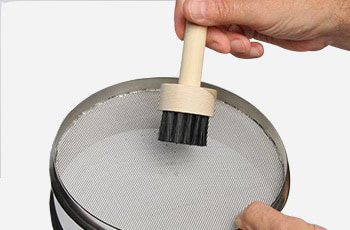
The process of cleaning a sieve correctly should commence even before its first use. Here are the steps to follow:
- Clean the sieve with warm water and a mild detergent solution to ensure accuracy from the start.
- While cleaning, brush the underside of the wire cloth in a circular motion with light pressure.
- Tap the sieve frame gently with a wooden brush handle to dislodge trapped particles without causing frame deformations.
By following these steps, you can ensure that your sieve is clean and ready for use.
Various sieves necessitate distinct cleaning methodologies. For sieves with finer meshes, washing with warm soap and water or using an ultrasonic cleaner can remove lodged particles, while a stainless steel brush or an old toothbrush may be more effective for stubborn debris on coarse meshes.
After cleaning, sieves should be air-dried to avoid damage from excessive heat, which can compromise the tensioned cloth or the adhesives used in sieve construction.
Coarse Mesh Cleaning
Generally, a brass wire brush for sieve is advocated for coarse mesh sieve cleaning brushes. The rigid bristles are designed to burrow through the large gaps and dislodge any particles that may be stuck. Coarse sieve cleaning brushes are specifically required for efficient cleaning of test sieves larger than #4, or 4.75 mm mesh size.
However, care must be taken not to damage the mesh during the cleaning process. When cleaning sieves with mesh sizes between #4 and #20, using a brush with medium/stiff bristles is recommended to ensure thorough cleaning while avoiding damage to the mesh. Thus, a balance between thoroughness and delicacy is required when cleaning coarse mesh sieves.
Fine Mesh Cleaning
Fine mesh sieves require a gentle touch to clean. Brushes with soft bristles, such as those made from camel hair, are ideal for cleaning fine mesh sieves from #200 to #270. The soft bristles remove lodged particles without causing damage to the delicate mesh. For sieves finer than 45 µm (#325), it is advised to avoid brushing altogether and instead clean them by immersing them in an ultrasonic bath.
After cleaning, fine mesh sieves should be rinsed under running water. If needed, a gentle scrub with a sponge and dish soap can be used, followed by air-drying to ensure no moisture is trapped. Burning off food particles with heat is not recommended as it can damage the fine mesh itself. Instead, manual cleaning methods with appropriate brushes preserve the integrity of the equipment.
Hence, maintaining the precision of a fine mesh sieve necessitates a gentle touch and the correct tools.
The Benefits of Quality Brushes for Sieves
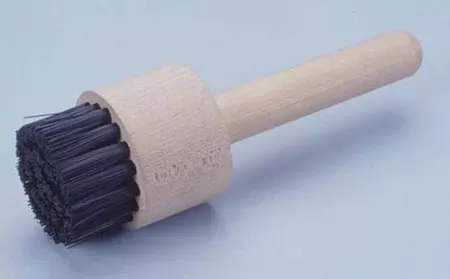
The decision to invest in high-quality brushes for sieves includes more than just the upkeep of your laboratory equipment. It impacts the accuracy of your testing results. Whether you are in a laboratory setting or an industrial environment, the quality of your sieve brushes can significantly influence the accuracy of your test sieves, thereby directly affecting your product quality or research findings.
Moreover, high-quality sieve brushes offer the following benefits:
- Extend the service life of your laboratory equipment
- Designed to withstand repeated use without losing their effectiveness
- Ensure that your sieves remain in optimal condition for extended periods
- Impact the longevity and accuracy of your sieves
Thus, the benefits of quality brushes extend beyond immediate cleaning and directly impact the longevity and accuracy of your wood sieves, making it essential to quantity add these tools to your arsenal.
Material and Construction
The effectiveness of a brush is significantly influenced by its materials and construction. The bristles of sieve brushes can be made from a variety of materials, including:
- Wire
- Brass wire
- Horsehair
- Palmyra barbs
Each material has unique properties that make it suitable for specific types of sieve meshes. For example, brass wire bristles are tough and can easily handle large, coarse particles, while horsehair bristles are softer and ideal for delicate, finer sieves.
The brush block, or handle, of brushes is commonly made from hardwood. This provides a solid and durable handle that allows for effective cleaning with free motion and enhanced control. Therefore, the material and construction of a sieve brush play a significant role in its cleaning performance and durability.
Durability and Performance
In the context of brushes for sieves, durability, and performance are closely intertwined. A durable brush maintains its cleaning efficiency over a prolonged period, thereby offering better value for money. The durability of sieve brushes is significantly influenced by the density of the bristles and the quality of construction. A well-constructed brush with densely packed bristles is likely to last longer and perform better than a poor-quality one.
Materials also affect the durability of sieve brushes. For example, brushes made from stainless steel are especially durable. They have high resistance to contamination, are easy to clean, and extend their lifespan, thereby improving performance. As such, investing in durable, high-performance sieve testing tools is a sound decision that can yield long-term benefits.
Brushes for Various Industries
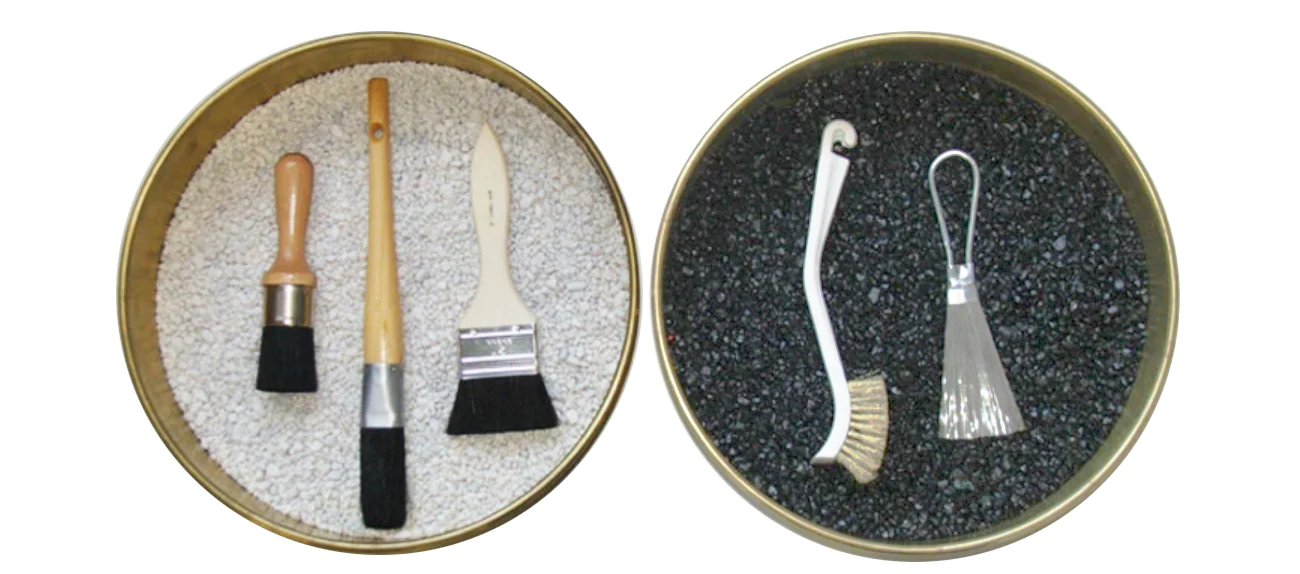
The use of sieves and brushes isn’t limited to laboratories. They play a crucial role in maintaining the efficiency and precision of sieving operations and equipment in various industries such as:
- Construction
- Agriculture
- Food processing
- Pharmaceuticals
- Mining
Each industry has its unique requirements and challenges that necessitate the use of specialized sieve brushes.
In the construction industry, quality sieve cleaning tools ensure effective separation and sizing of materials, while in the agriculture industry, natural fiber brushes are used to avoid contamination during seed cleaning. The mining industry utilizes heavy-duty sieve brushes with stiff bristles to clean rugged mining sieves and screens. Thus, quality sieve cleaning tools are versatile tools that find application in a variety of industrial settings.
Construction and Aggregate Testing
Sieve brushes are essential in construction and aggregate testing for ensuring successful material separation and sizing. The quality of construction depends largely on the accurate particle size distribution of the materials used. Specialized sieve testing tools help maintain this accuracy by removing fine particles from the mesh without damaging it.
The construction industry often deals with coarse materials such as gravel and sand, making durability a key attribute of sieve brushes used in this industry. Thus, utilizing top-quality sieve cleaning tools correlates with more reliable construction materials testing, contributing to the structural integrity of buildings and infrastructures.
Food Processing and Pharmaceuticals
Sieve brushes in food processing and pharmaceuticals fulfill a dual purpose: maintaining precision in particle size distribution and upholding rigorous hygiene standards. This is achieved through the use of specific kinds of brushes such as hygienically-fused bristle brushes, which ensure no fibers are shed during cleaning, and brushes made from FDA-approved materials to meet strict hygiene and safety standards.
In pharmaceuticals, very soft bristle brushes like camel hair are used to clean delicate equipment and sieves, while metal bristle brushes are used for coarse sifting applications involving No. You can use 30 or coarser wire mesh for this project. It will provide the necessary strength and durability. In the food processing industry, brushes with soft natural hairs are preferred to prevent contamination when cleaning fine mesh sieves. Thus, the selection of sieve brushes in these industries is driven by the need for precision, hygiene, and safety.
How to Maintain Your Sieve Brushes
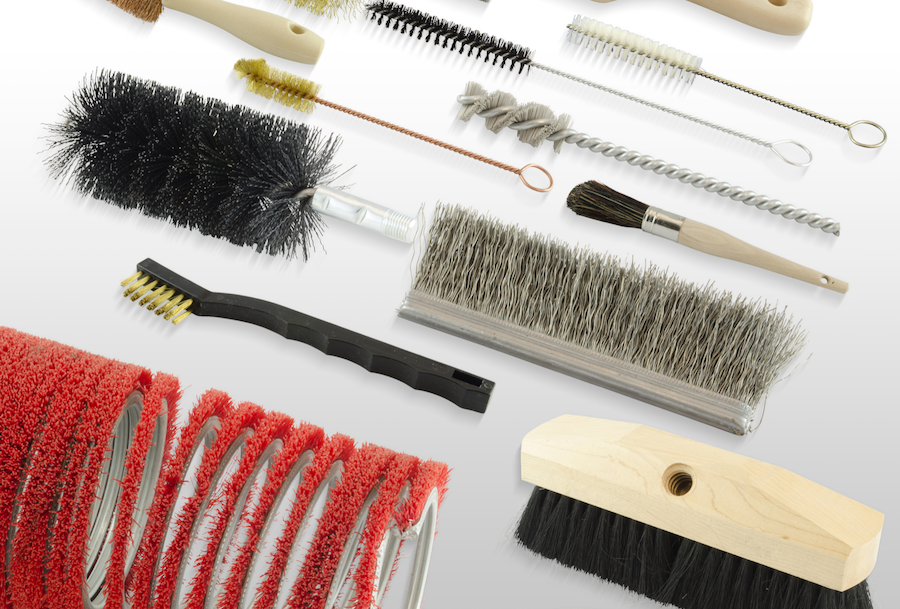
The importance of maintaining your sieve brushes parallels that of using them. Proper care and regular maintenance keep your brushes in top condition, ensuring optimal performance and significantly extending their service life. Regular visual brush inspections help identify any damage or wear and tear that could adversely affect their performance.
When cleaning sieve brushes, it’s important to follow these steps to maintain their effectiveness and prevent damage:
- Avoid applying excessive pressure to the bristles.
- After cleaning, ensure the sieve and brush are completely dry before their next use.
- Regularly check for any signs of mildew or brush degradation.
By following these steps, you can ensure the longevity and efficiency of your sieve brushes.
Regular Cleaning
Routine cleaning of sieve brushes guarantees the recovery of all sample material and the removal of particles stuck in the mesh. The underside of the mesh should be brushed gently in a circular motion with a sieve brush, and the sieve frame tapped to check for and remove any residue and any clinging particles.
However, it’s important to note that cleaning doesn’t mean being aggressive with your brush. Excessive force can damage the bristles and reduce the cleaning effectiveness of the brush. Therefore, a gentle, thorough cleaning after each sieve use can keep your sieve brushes in prime condition and ensure their longevity.
Proper Storage
The proper storage of sieve brushes is a frequently disregarded facet of brush maintenance. Brushes should be stored in a controlled environment that is clean and dry to avoid any damage to the bristles and handle. Rapid temperature changes or high humidity can degrade the materials of the brush, thereby reducing its lifespan.
Moreover, it is important not to store the brushes in a way that bends the bristles or compresses them against a surface, as this can change their shape and reduce their effectiveness. Proper storage ensures your brushes remain in optimal condition for longer, ready to deliver top performance when you need them. So, when you cart buy these brushes, make sure to store them correctly. For more information, you can check out related blogs on brush care and maintenance.
Summary
Sieve brushes may seem like simple tools, but they play a crucial role in maintaining the efficiency and precision of sieving operations across various industries. Whether it’s the construction, food processing, or pharmaceutical industry, the right sieve brush can ensure accurate results and prolong the lifespan of your test sieves.
Investing in high-quality sieve testing tools is a sound decision that pays off in the long run. Regular cleaning and proper storage can further enhance and maintain the longevity of your brushes, ensuring they continue to deliver optimal performance for years to come. So, take care of your sieve testing tools, and they’ll take care of your sieving operations.
Certified MTP has an elite selection of lab solutions, showcasing industry-leading brands including lab brushes, sieve brushes, Test Tube brushes with Nylon brushes in varying sizes and Test Tube Brush with Natural Bristles.
Frequently Asked Questions
Why are sieve brushes important?
Sieve brushes are important because they help preserve the integrity of test sieves, ensuring accurate aggregate testing results.
How do I select the right sieve brush?
When selecting the right sieve brush, consider the mesh size, brush material, and filament diameter to prevent damage and ensure effective cleaning.
Are there different cleaning techniques for coarse and fine mesh sieves?
Yes, coarse mesh sieves require brass wire brushes or medium/stiff bristle brushes, while fine mesh sieves need soft bristle brushes and gentle brushing techniques to prevent damage.
How should I store my sieve brushes?
Store your sieve brushes in a clean, dry environment to protect the bristles and handle from damage. Avoid storing them in a way that bends or compresses the bristles against a surface.
Can I use the same sieve brush for different industries?
No, it’s recommended to use specialized brushes for sieves for different industries due to specific requirements, such as soft natural hairs for the food processing industry to prevent contamination.
Related Blogs for Sieve Brushes:
Comprehensive List of Biology Laboratory Equipment in 2023
Chemistry Glassware Names: A Comprehensive Guide
Test Tube Brush: Understanding Function and Uses
Top Scrub Brush for Concrete: Your Ultimate Cleaning Tool
Quality Lab Brushes for Efficient Cleaning and Maintenance
Top Scrub Brush for Concrete: Your Ultimate Cleaning Tool
Sizes of Sieves: A Comprehensive Guide
Sieve Test: A Guide to Particle Size Analysis
Gilson Shakers: Precision Screeners & Shaker Screens
Gilson Screens: Discover the Benefits
Complete Guide to US Sieve Sizes
Gilson Company Testing Equipment: Discover Durability
Gilson Screens: Discover the Benefits
View the full line of Aggregate Moisture Testing Equipment, especially the popular Aggregate/Sand Moisture Measurement System

